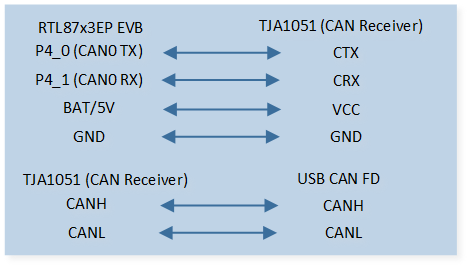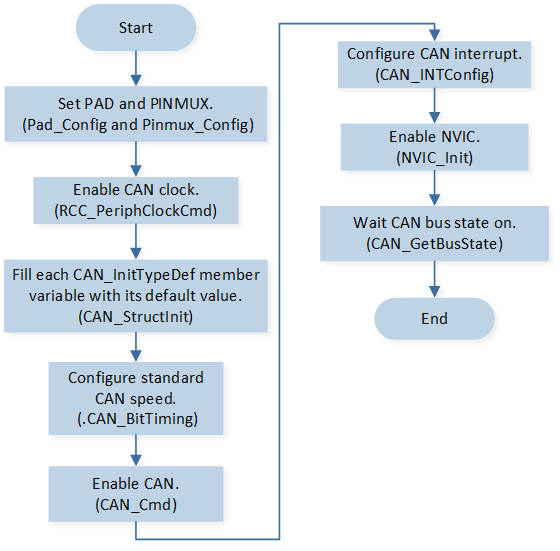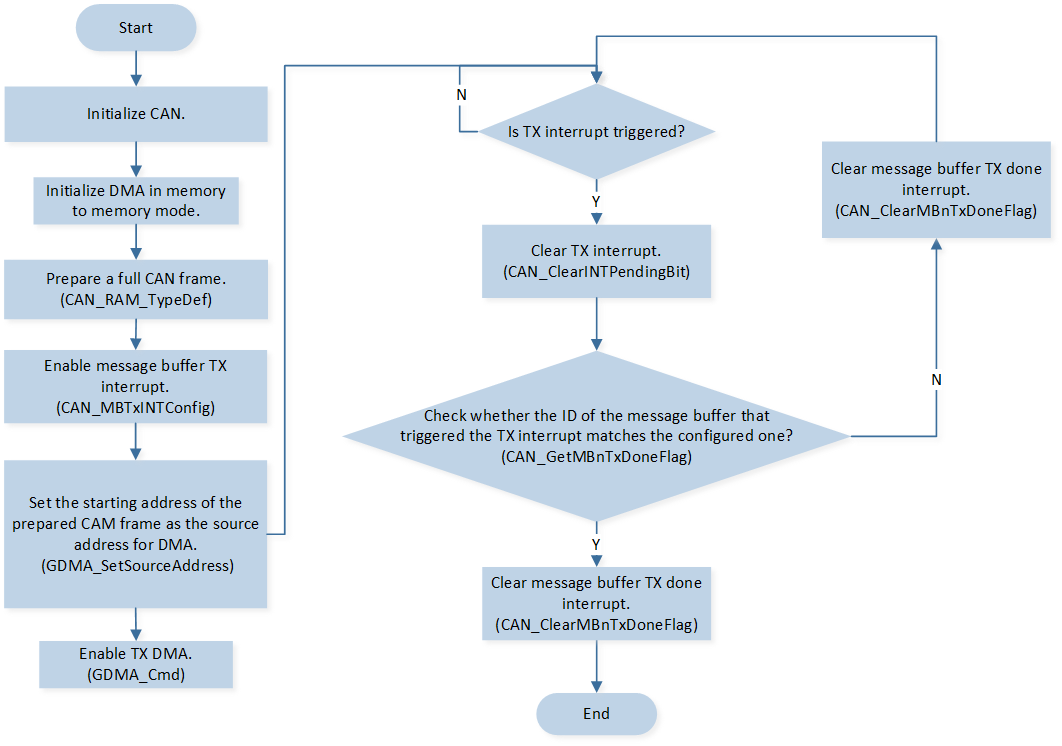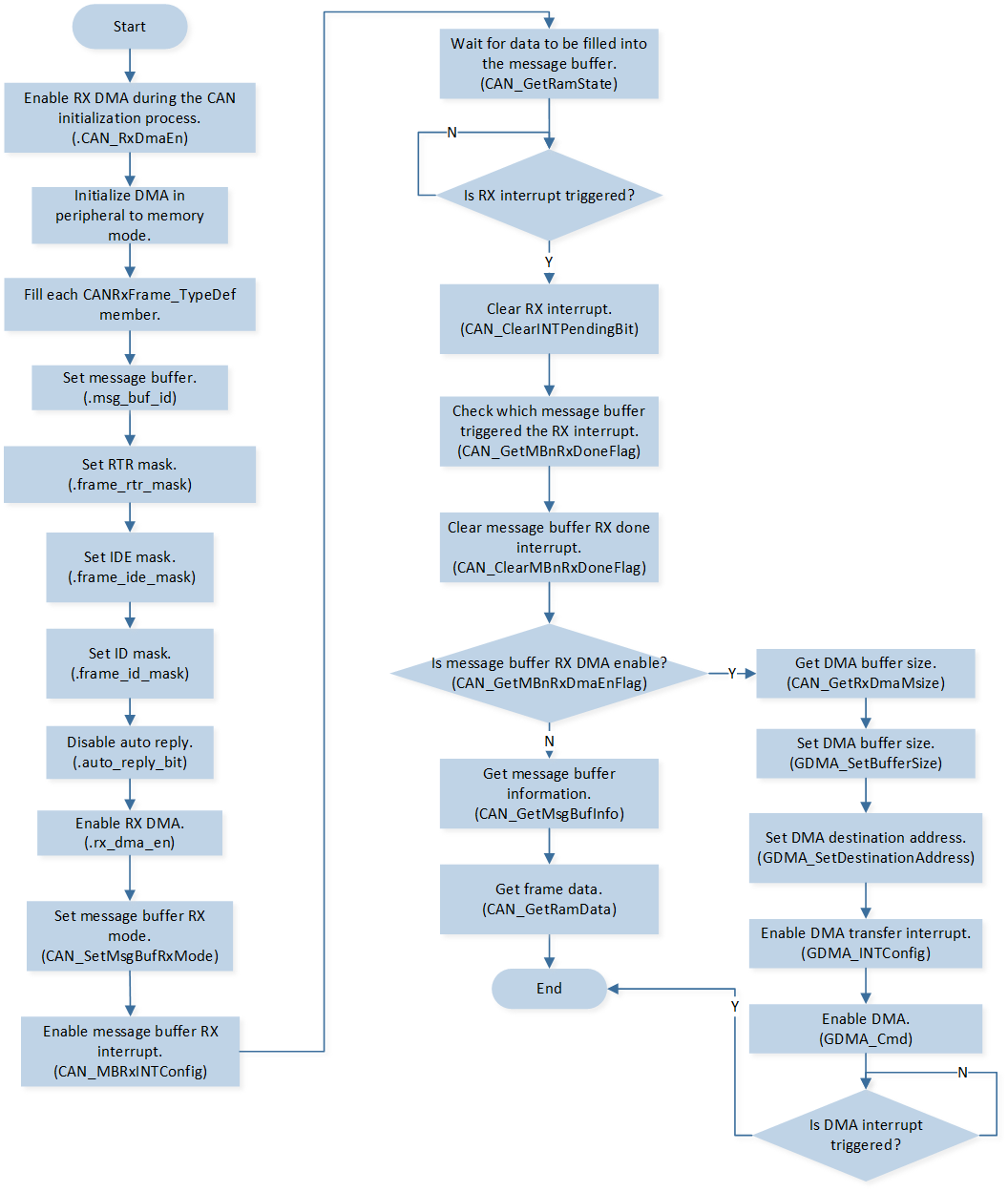Transmit and Receive - GDMA
This sample demonstrates the functionality of sending and receiving data via CAN using GDMA.
The CAN controller is connected to a USB CAN analyser and communicates with the CAN controller by sending and receiving standard data frames, extended data frames, standard remote frames, extended remote frames and other frame types through the PC side.
Requirements
For hardware requirements, please refer to the Requirements.
Wiring
The EVB is connected to a TJA1051 CAN Receiver module by connecting P4_0 to CTX, P4_1 to CRX. The EVB BAT/5V is connected to the module VCC and NC. The EVB GND is connected to the module GND and S.
The other end of the TJA1051 CAN Receiver module is connected to the PC via a USB CAN analyzer, by connecting module CANH to analyzer CANH and module CANL to analyzer CANL.

CAN TRX Demo Code Hardware Connection Diagram
The introduction of CAN transceiver can refer to CAN Transceiver Introduction .
Configurations
The following macros can be configured to modify CAN pin definitions.
#define CAN_TX_PIN P4_0 #define CAN_RX_PIN P4_1
The following macros can be configured to modify TX/RX message buffer ID.
#define TX_DMA_BUF_ID 0 #define RX_DMA_BUF_ID 1
The entry function is as follows, call this function in
main()to run this sample code. For more details, please refer to the Initialization.can_trx_dma_demo();
Building and Downloading
For building and downloading, please refer to the Building and Downloading.
Experimental Verification
Press the Reset button on the EVB and the message will be displayed in the Debug Analyzer.
can_trx_dma_demo: start
After the IC is reset, a data frame sent by the IC is received on the tool.
The IC prints the log waiting to be received.
can_driver_init: BUS state: 0, waiting... can_driver_init: BUS ON 1 can_tx_dma_handler: TX DONE! can_dma_rx: waiting for rx...
Send a data frame using the tool.
The IC receives the data frame via GDMA and prints log.
can_trx_handler: CAN RX can_trx_handler: MB_1 rx done can_rx_dma_handler: std id = 0x00000100, ext id = 0x00000000 dlc = 8 can_rx_dma_handler: rx_data [0] 0x01 can_rx_dma_handler: rx_data [1] 0x23 can_rx_dma_handler: rx_data [2] 0x45 can_rx_dma_handler: rx_data [3] 0x67 can_rx_dma_handler: rx_data [4] 0x89 can_rx_dma_handler: rx_data [5] 0xab can_rx_dma_handler: rx_data [6] 0xcd can_rx_dma_handler: rx_data [7] 0xef can_rx_dma_handler: waiting for rx...
Code Overview
This section introduces the code and process description for initialization and corresponding function implementation in the sample.
Source Code Directory
The directory for project file and source code are as follows.
For project directory, please refer to Source Code Directory.
Source code directory:
sdk\sample\io_demo\canbus\trx_dma\can_trx_dma.c.
Initialization
The initialization flow for peripherals can refer to Initialization Flow.
CAN initialization flow is shown in the following figure.

CAN Init Flow
Call
Pad_Config()andPinmux_Config()to configure the corresponding pin’s PAD and PINMUX.void can_board_init(void) { /* Config pinmux and pad for CAN. */ Pinmux_Config(CAN_TX_PIN, CAN_TX); Pinmux_Config(CAN_RX_PIN, CAN_RX); Pad_Config(CAN_TX_PIN, PAD_PINMUX_MODE, PAD_IS_PWRON, PAD_PULL_NONE, PAD_OUT_DISABLE, PAD_OUT_LOW); Pad_Config(CAN_RX_PIN, PAD_PINMUX_MODE, PAD_IS_PWRON, PAD_PULL_NONE, PAD_OUT_DISABLE, PAD_OUT_LOW); }
Call
RCC_PeriphClockCmd()to enable the CAN clock.Initialize the CAN peripheral.
Define a
CAN_InitTypeDeftypeinit_structand callCAN_StructInit()to pre-fillinit_structwith default values.Modify the
init_structparameters as needed. The CAN initialization parameters are configured as shown in the table below.Call
CAN_Init()to initialize the parameters and the CAN peripheral.
CAN Hardware Parameters |
Setting in the |
CAN |
|---|---|---|
Auto Re-transmit Enable |
||
CAN Speed Parameter - BRP |
3 |
|
CAN Speed Parameter - SJW |
3 |
|
CAN Speed Parameter - TSEG1 |
13 |
|
CAN Speed Parameter - TSEG2 |
4 |
|
RX GDMA Enable |
Call
CAN_Cmd()to enable the corresponding CAN peripheral.Call
CAN_INTConfig()to configure the CAN receive completeCAN_RX_INTinterrupt, transmit completeCAN_TX_INTinterrupt, error interruptCAN_ERROR_INT, etc. Configure NVIC, and refer to Interrupt Configuration for NVIC-related configurations.Call
CAN_GetBusState()to loop-check the CAN bus state and wait for the CAN bus to open.while (CAN_GetBusState() != CAN_BUS_STATE_ON) { __asm volatile ( "nop \n" ); }
Note
If the program is stuck at the point of waiting for the CAN bus to be on, please check if the CAN bus is connected correctly.
Call
RCC_PeriphClockCmd()to enable the GDMA clock.Call
GDMA_channel_requestto request a free GDMA channel and register the GDMA interrupt handler.Initialize the GDMA peripheral.
Define a
GDMA_InitTypeDeftypeGDMA_InitStructand executeGDMA_StructInit()to pre-fillGDMA_InitStructwith default values.Modify the
GDMA_InitStructparameters as needed. The initialization parameter configuration for GDMA TX and RX channels is shown in the following table. ExecuteGDMA_Init()to initialize the GDMA peripheral.Configure the GDMA total transfer complete interrupt
GDMA_INT_Transferand NVIC. Refer to Interrupt Configuration for related NVIC configurations.
GDMA Hardware Parameters |
Setting in the |
GDMA TX Channel |
GDMA RX Channel |
|---|---|---|---|
Channel Num |
|
|
|
Transfer Direction |
|||
Buffer Size |
|
- |
|
Source Address Increment or Decrement |
|||
Destination Address Increment or Decrement |
|||
Source Data Size |
|||
Destination Data Size |
|||
Source Burst Transaction Length |
|||
Destination Burst Transaction Length |
|||
Source Address |
- |
|
|
Destination Address |
|
- |
|
Source Handshake |
- |
||
Destination Handshake |
- |
- |
Note
During the initialization of the GDMA peripheral, do not initialize the source address of the TX GDMA channel and the destination address of the RX GDMA channel; these will be adjusted dynamically later.
Functional Implementation
CAN TX GDMA flow is shown in the following figure.

CAN TX GDMA Flow
CAN RX GDMA flow is shown in the following figure.

CAN RX GDMA Flow
Call the
can_dma_txfunction to configure the valuetx_can_ram_structthat needs to be set in the RAM register via TX GDMA.Call the
can_start_tx_dmafunction.Set the source address of the TX GDMA channel to the address of
tx_can_ram_struct.Enable the
GDMA_INT_Transferinterrupt for TX GDMA.Enable the GDMA peripheral to start the transmission.
static void can_start_tx_dma(uint8_t buf_id, CAN_RAM_TypeDef *p_can_ram_data) { CAN_MBTxINTConfig(CAN0, buf_id, ENABLE); GDMA_SetSourceAddress(TX_DMA_Channel, (uint32_t)p_can_ram_data); GDMA_INTConfig(TX_DMA_CHANNEL_NUM, GDMA_INT_Transfer, ENABLE); GDMA_Cmd(TX_DMA_CHANNEL_NUM, ENABLE); }
After enabling the GDMA TX channel, GDMA transfers data from
tx_can_ram_structto(CAN0->CAN_RAM_DATA). When TX is completed, a GDMA TX interrupt is triggered, and relevant information is printed.GDMA_INTConfig(TX_DMA_CHANNEL_NUM, GDMA_INT_Transfer, DISABLE); IO_PRINT_INFO0("can_tx_dma_handler: TX DONE!"); GDMA_ClearINTPendingBit(TX_DMA_CHANNEL_NUM, GDMA_INT_Transfer);
Call the
can_dma_rxfunction.Mask the reception of frames rtr, ide, and id filtering, i.e., receive all frames.
Enable RX GDMA and disable automatic reply.
Configure the message buffer to receive mode using the set reception frame type.
Enable message buffer reception interrupt and wait for the RAM status to be idle.
... rx_frame_type.msg_buf_id = RX_DMA_BUF_ID; rx_frame_type.frame_rtr_mask = CAN_RX_FRAME_MASK_RTR; rx_frame_type.frame_ide_mask = CAN_RX_FRAME_MASK_IDE; rx_frame_type.frame_id_mask = CAN_RX_FRAME_MASK_ID; rx_frame_type.rx_dma_en = SET; rx_frame_type.auto_reply_bit = RESET; rx_error = CAN_SetMsgBufRxMode(CAN0, &rx_frame_type); CAN_MBRxINTConfig(CAN0, rx_frame_type.msg_buf_id, ENABLE); while (CAN_GetRamState(CAN0) != CAN_RAM_STATE_IDLE) ...
When the message buffer reception is complete, execute the interrupt handler function
can_trx_handler.Call the
can_start_rx_dmafunction to enable the configuration of the GDMA buffer size, configure the destination address of the GDMA RX channel, and enable RX GDMA transmission.
if (dma_en_flag == ENABLE) { /* This value is fixed 4. */ uint32_t dma_buffer_size = 4; can_start_rx_dma((uint32_t)&rx_dma_data_struct, dma_buffer_size); }
After enabling the GDMA RX channel, when CAN receives data, the GDMA transfers the data from
&(CAN0->CAN_RX_DMA_DATA)torx_dma_data_struct. When the RX GDMA reception is complete, the interrupt handler functioncan_rx_dma_handleris executed.Disable the
GDMA_INT_Transferinterrupt for RX GDMA.Enable the RX GDMA of the message buffer to start the next reception.
Print the received frame ID and print the received frame data.
Clear the
GDMA_INT_Transferinterrupt flag for RX GDMA.
GDMA_INTConfig(RX_DMA_CHANNEL_NUM, GDMA_INT_Transfer, DISABLE); CAN_SetMBnRxDmaEnFlag(CAN0, RX_DMA_BUF_ID, ENABLE); ... GDMA_ClearINTPendingBit(RX_DMA_CHANNEL_NUM, GDMA_INT_Transfer);